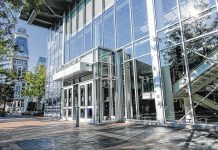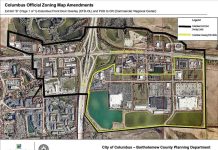A leap of faith by a former publishing executive resulted in the creation of a building that became a cornerstone of a downtown Columbus redevelopment effort and an architectural icon.
The Republic’s office at 333 Second St. was born from a vision that started in the 1960s. Chicago-based architectural firm Skidmore, Owings and Merrill had created a plan for the city to remove blight south of Fifth Street and strengthen the retail climate.
Bob Brown, publisher of The Republic and chairman of its parent company, Home News Enterprises, bought into the vision and in 1969 chose the lot at Second and Washington streets as new home for The Republic’s newspaper operations.
The building opened two years later and was considered innovative for its transparency with an all-glass exterior, making the printing press — which could be seen running from the outside — its showpiece. Traditionally, newspaper printing presses were located in the basements of buildings.
[sc:text-divider text-divider-title=”Story continues below gallery” ]
“Architect Myron Goldsmith saw it as a rotating sculpture basically,” Jeff Brown — son of the late Bob Brown, and group president of AIM Media Indiana, said of the printing press.
“We had a lot of other newspapers that visited here and that resulted in other newspaper companies with presses being displayed in their windows. This was one of the first, if not the first, to do that,” Jeff Brown said.
The building was designated a National Historic Landmark in 2012, the seventh in Columbus to earn that distinction, cited as “an exceptional work of Modern architecture and one of the best examples of the work of Myron Goldsmith.”
A general partner in the firm Skidmore, Owings & Merrill, Goldsmith was a highly respected architect, architectural theorist, writer and educator.
http://www.therepublic.com/2016/05/26/columbus-regional-health-affiliate-purchases-republic-building/
Goldsmith had previously designed a new building for the Daily Journal, a newspaper Bob Brown started in Franklin in 1962. Brown liked the work Goldsmith did, and hired him to design a new home for The Republic, and base it on the production system of the newspaper at the time.
Functionally, the property Bob Brown chose placed The Republic in a center of activity, near the Bartholomew County Courthouse, City Hall, police agencies and The Commons mall.
Brown and family members owned the building for 45 years until it was purchased Thursday by Southeastern Indiana Medical Holdings, an affiliate company of Columbus Regional Health. The health system is expected to locate some of its services in the building sometime next year.
Jeff Brown said selling the building was as hard as selling the family’s newspaper business. Texas-based AIM Media purchased The Republic and its sister newspapers — operated as Home News Enterprises — on Nov. 1.
“It’s very difficult. This is my dad’s building. He put a lot of himself in this,” he said.
Jeff Brown said his father and Goldsmith worked together well because Goldsmith was a structural engineer and his dad was an electrical engineer.
“The two really charted a course for how to build an offset printing plant for newspapers, which was new technology at the time,” Brown said.
Central to the design was the newspaper’s Goss Urbanite press. The building’s all-glass concept allowed residents to watch the press as it was printing The Republic.
“Dad said we want to be transparent to the community,” Jeff Brown said.
The building was complex, featuring a lot of symmetry, and Bob Brown and Goldsmith spent a lot of time getting it right, Jeff Brown said.
The building was designed for a distinct newspaper workflow, with the editorial department on one side, advertising on the other, offices in center, and stories and ads flowing to the press and the printed paper flowing out to the parking lot to be delivered.
Cubicles were an innovation in 1970s, Jeff Brown said, and his dad would spend hours determining the proper height for those in the office.
The sale of The Republic building is another sign of the changing times of the newspaper industry.
In 1998, The Republic’s press was removed from the building and moved to a new printing plant off Interstate 65. The emergence of the internet and various social media platforms has hastened more changes for newspapers in recent years.
“The industry has changed and buildings like this that were built for the complexities of front to back newspaper production are really no longer suitable for today’s new media environment,” Jeff Brown said. “Newspapers have to be more flexible and scalable.”
[sc:pullout-title pullout-title=”Pull Quote” ][sc:pullout-text-begin]
“This is my dad’s building. He put a lot of himself in this.”
— Jeffrey Brown, group president of AIM Media Indiana
[sc:pullout-text-end]




